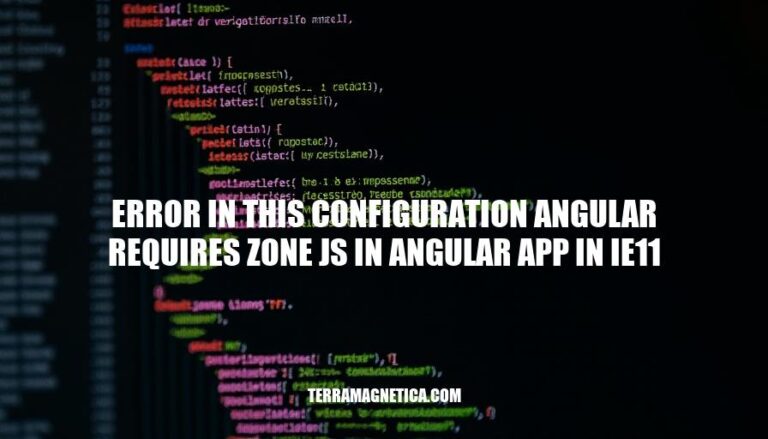


In Angular applications running on Internet Explorer 11 (IE11), developers often encounter the error message: “In this configuration, Angular requires Zone.js.” This issue arises because Zone.js, a library essential for Angular’s change detection mechanism, is not properly configured or supported in IE11.
The significance of this error lies in its impact on the application’s functionality. Without Zone.js, Angular cannot efficiently track and update changes in the application, leading to potential performance issues and broken features. This makes it crucial for developers to address this error to ensure their Angular applications run smoothly on IE11.
The error message “In this configuration Angular requires Zone.js” in an Angular application running on Internet Explorer 11 (IE11) typically occurs due to the absence or incorrect version of Zone.js. This error is particularly common when using Angular versions that rely on Zone.js for change detection and asynchronous operations.
Zone.js is a library that patches asynchronous operations in JavaScript, such as:
In Angular, Zone.js plays a crucial role in the framework’s change detection mechanism. It creates a “zone” or execution context that keeps track of all asynchronous operations. When an asynchronous operation completes, Zone.js triggers Angular’s change detection to update the view accordingly.
Consider an Angular application that makes an HTTP request to fetch data. Without Zone.js, Angular would not automatically know when the HTTP request completes, and the view would not update unless manually triggered. With Zone.js, the completion of the HTTP request is tracked, and Angular’s change detection is automatically triggered to update the view with the new data.
To resolve the “In this configuration Angular requires Zone.js” error in IE11:
By addressing these points, you can ensure that your Angular application runs smoothly in IE11 with the necessary support from Zone.js.
The error “In this configuration Angular requires Zone.js” in IE11 typically arises due to compatibility issues with Zone.js versions and Angular configurations. Here are the primary causes and common scenarios:
Zone.js Version Mismatch: Using an incompatible version of Zone.js can trigger this error. For instance, Zone.js 0.10.1 has known issues with IE11, whereas 0.10.0 works fine.
Polyfills Configuration: Angular applications targeting older browsers like IE11 require specific polyfills. Missing or incorrectly configured polyfills can lead to this error. Ensure that zone.js is included in the polyfills.ts file.
Angular Version Compatibility: Different Angular versions have varying dependencies on Zone.js. Upgrading Angular without updating Zone.js or vice versa can cause compatibility issues.
Third-Party Libraries: Integrating Angular with other libraries or frameworks that manipulate the global execution context can conflict with Zone.js, leading to errors.
Custom Change Detection: Angular 18 introduced the option to remove Zone.js for custom change detection. Misconfigurations during this process, such as not properly setting up provideExperimentalZonelessChangeDetection, can cause errors.
These scenarios highlight the importance of ensuring compatibility between Angular, Zone.js, and the target browser, especially when dealing with legacy browsers like IE11.
Sure, here are the steps to troubleshoot and resolve the “Angular requires Zone.js” error in an Angular application running in IE11:
Check Polyfills:
zone.js is included in your polyfills.ts file.import 'zone.js/dist/zone'; // Included with Angular CLI.
Update Angular Configuration:
angular.json file includes the necessary polyfills."polyfills": [
"zone.js"
]
Install Zone.js:
zone.js is installed in your project.npm install zone.js --save
Include Zone.js in HTML:
zone.js directly in your index.html.<script src="node_modules/zone.js/dist/zone.min.js"></script>
Check Browser Compatibility:
import 'core-js/es6';
import 'core-js/es7/reflect';
Verify Angular Version:
Run Application:
ng serve
Following these steps should help you resolve the issue with Zone.js in your Angular application running in IE11.
To avoid the “error in this configuration Angular requires Zone.js” in IE11, follow these best practices:
Polyfills:
zone.js is included in your polyfills.ts file.core-js and classlist.js.Browser Compatibility:
browserslist configuration to specify supported browsers.es5 builds are enabled for older browsers.Angular Configuration:
target to es5 in tsconfig.json.differential loading to serve modern code to modern browsers and legacy code to older browsers.Coding Practices:
NgZone.runOutsideAngular for third-party libraries to prevent unnecessary change detection.Testing:
Implementing these practices will help ensure your Angular app runs smoothly in IE11.
In an Angular application running in IE11, follow these key steps:
npm install or by directly including it in index.html.Additionally, consider implementing best practices such as: